By BRENDA JOSEPHSON
This Mother’s Day, treat Mom to delightful foraged dandelions. With dandelions blooming throughout Alaska, there is a perfect opportunity to gather sustainable greens and flowers that will add a special touch to your Mother’s Day table. Below, you’ll find some recipe suggestions for dandelion iced tea, a salad with citrus vinaigrette, sunny dandelion eggs, and dandelion baked halibut.
Mother’s Day celebrates the unconditional love and nurturing spirit of moms. Reflecting on moments spent gathering dandelions for your mother serves as a beautiful way to honor her. Dishes inspired by dandelions can showcase vibrant greens and blossoms, providing a meaningful way to pay tribute to her with simple creations that remind us of the joys that nature offers.
Dandelions truly are a gift from God, despite being unjustly labeled as undesirable invasive weeds. They are a dense superfood, rich in multiple vitamins, including A, C, and K, and they also provide essential minerals such as iron, potassium, magnesium, calcium, and beta-carotene.
All parts of the plant are edible, including the roots, stems, leaves, and blossoms. Dandelions are considered safe to eat in large amounts and have been harvested as food and medicine for over a thousand years.
Dandelions (Taraxacum officinale), also known as the lion’s tooth flower, originated in Eurasia and have evolved over millions of years to survive in diverse climates and soils. Since ancient times, they have been used as a nutritional source, with references to dandelion salads, teas, and wine found in Roman and Chinese texts dating back to around 900 CE. It is believed that the 17th-century European settlers purposely transported the dandelion to North America. Its presence in the new world is noted as occurring around the time of the Mayflower, according to an article published by the National Library of Medicine.
Since their arrival in North America, dandelions have spread across the continent, becoming a familiar sight. Today, their resilience and adaptability have led some to regard them as an undesirable invasive weed, while others continue to appreciate their value as both food and medicine.
According to Rosalee De La Foret in her book Alchemy of Herbs, herbalists value dandelion leaves for the potential they provide in aiding liver health, digestion, and as a diuretic. She also states that the dandelion root is used by herbalists for arthritis and to support the health of people with cancer. Dandelion is also used topically to treat skin conditions.
Dandelions are pollen-producing plants that benefit bees and other pollinators essential for our planet’s survival. However, some individuals may develop allergies to dandelion pollen, similar to allergies caused by goldenrod and ragweed. Herbalist Rosemary Gladstar warns in her reference guide, Medicinal Herbs, that allergies can also stem from the milky latex found in dandelion flowers and stems. She advises, “If a rash develops upon use of this latex, just discontinue the treatment.”
For culinary applications, dandelion blooms are valued for their beautiful vibrant burst of color in dishes. You can also enjoy them as fritters, fry them in butter, and use them to make jam and wine. Their slightly bitter flavor complements a wide range of ingredients, making them a versatile choice in both savory and sweet recipes.
Dandelion leaves possess a savory sharpness that enhances and brightens a fresh salad and complements milder lettuces. They can also be sautéed just until they start to wilt and finished with olive oil, lemon juice, garlic, turmeric, salt, and pepper, or prepared with a balsamic option. Additionally, the leaves can be transformed into a delicious pesto with walnuts, garlic, lemon, seasonings, and Parmesan cheese. They also provide a finishing touch to egg dishes, imparting a unique earthy essence to scrambled eggs, frittatas, or quiches. The potential is limitless.
The dandelion root can be used in various dishes, including roasted vegetables and stir-fries, or infused in apple cider vinegar to make salad dressings and marinades. Roasted dandelion roots have a distinct flavor with bitter undertones that can be used as a coffee replacement or supplement to reduce caffeine intake. Harvesting dandelions for their roots is most effective later in the summer when the roots have fully developed and grown larger.
Teas made from dandelion may include the leaves, flowers, or roasted roots of the dandelion plant. These teas can also incorporate additional ingredients, such as mushrooms, herbs, spices, and honey.
All the potential opportunities to include dandelions in your meals can create an exciting culinary adventure and a way to introduce a healthy superfood to your diet that is free of cost and sustainable to harvest.
When foraging for dandelions, make sure the area is free of contamination caused by lawn maintenance or road traffic. Be sure to correctly identify the plants, as lookalikes may potentially be toxic. Before eating dandelions, always wash them well to remove any dirt or insects. The young, tender leaves in spring are the most desirable, as they become increasingly bitter as the plant matures.
Dandelions are a plant that you do not need to worry about overharvesting. Those who consider dandelions an invasive weed attempt to eradicate them each summer, pulling them by their roots and dousing them with herbicides. Nevertheless, dandelions continue to expand their reach, offering their heavenly gifts to pollinators, animals, and humans in new and distant regions, far beyond their origins in Eurasia.
Like our mothers, the dandelion is a remarkable wonder of nature that offers both sustenance and healing with incredible resilience and adaptability, thriving in Alaska’s harsh surroundings despite numerous challenges. Its ability to flourish in unexpected ways reflects the strength and perseverance that our mothers exhibit in their daily lives.
It serves as a reminder of the nurturing qualities found in both dandelions and mothers, who overcome adversity to create beauty and sustenance. Just as the dandelion disperses its seeds to ensure future growth, so too do mothers cultivate hope and possibility for the generations to come.
Mother’s Day is a day for us to honor the special person in your life, whether she a mother or simply someone who embodies a motherly energy. If you are not inclined to try out dandelion recipes, you could always bring her a dandelion bouquet instead.
Below are a few dandelion recipe ideas.
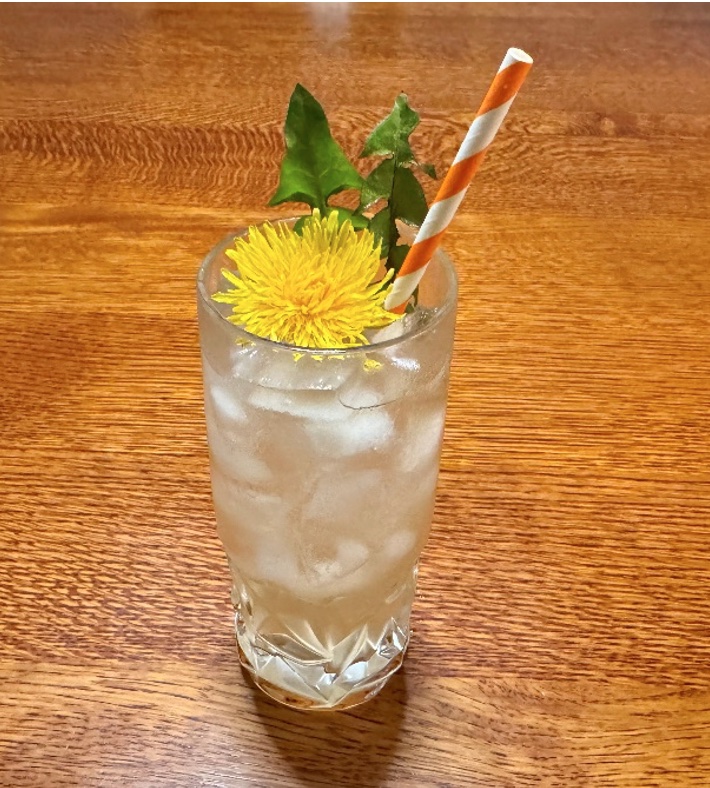
Iced Dandelion Blossom Tea
Ingredients:
2 ½ cups of fresh dandelion flower heads
5 cups of water
2 tablespoons of honey, more or less to taste
1 lemon, washed and juiced (approximately 2 tablespoons)
For the garnish:
10 to 12 fresh dandelion leaves
5 to 6 fresh dandelion blooms
Makes 5 to 6 servings.
Preparation:
Harvest the dandelion flowers when it is sunny and the blooms are fully open. Gently rinse the blossoms under cold water to remove dirt and insects. Then separate the yellow petals from the green base to remove and discard the bitter portion of the bloom. This process will yield just over one cup of clean yellow petals.
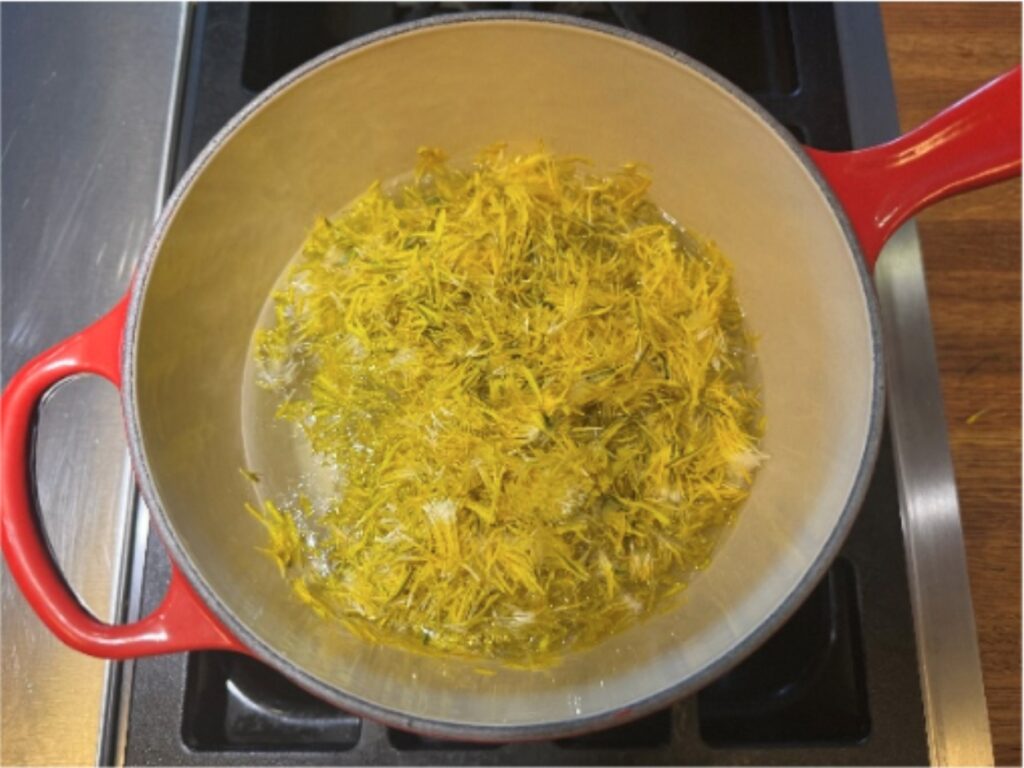
Bring the water to a boil. Turn off the heat and immediately add the dandelion petals, the lemon juice, and the rind of the lemon for extra zest. Let it steep for 15 to 30 minutes to extract the floral flavor.
Remove the lemon rind and strain the tea through a fine mesh sieve, discarding the petals. Add the honey and stir until it dissolves, taste, and add more honey if desired. Chill the tea in the refrigerator for about an hour.
Serve the dandelion tea in a glass, poured over ice, and garnish it with a couple of fresh dandelion leaves and a bloom.
Enjoy the fresh flavor of this cool beverage!

Dandelion Walnut and Citrus Salad
Ingredients:
For the salad:
4 cups fresh young dandelion greens
½ cup red onions, thinly sliced
½ cup walnuts, toasted
½ cup feta cheese, crumbled (optional)
1 orange, segmented and cut into small bite-sized pieces
2 to 3 fresh dandelion blooms for garnish, gently rinsed and patted dry
For the citrus vinaigrette:
1 orange, freshly squeezed (approximately 3 tablespoons of orange juice)
1 lemon, freshly squeezed (approximately 2 tablespoons of lemon juice)
1 teaspoon mustard (yellow, brown, and Dijon all work well)
1 ½ teaspoons honey
½ teaspoon ground ginger
¼ cup extra-virgin olive oil
Sea salt and freshly ground pepper, to taste
Makes 4 servings.
Start by preparing the vinaigrette. In a small bowl, whisk together the orange juice, lemon juice, mustard, ginger, and honey until well combined. Alternatively, you can use a hand immersion blender to combine. While continuing to whisk or blend the mixture, slowly drizzle in the olive oil into the vinaigrette. Season with salt and pepper to taste.
Thoroughly rinse the greens in cold water to remove soil or insects. Remove the stems from the dandelion greens, then tear the leaves into bite-sized pieces. Rinse the greens again and remove excess water by spinning them in a salad spinner or by patting them dry.
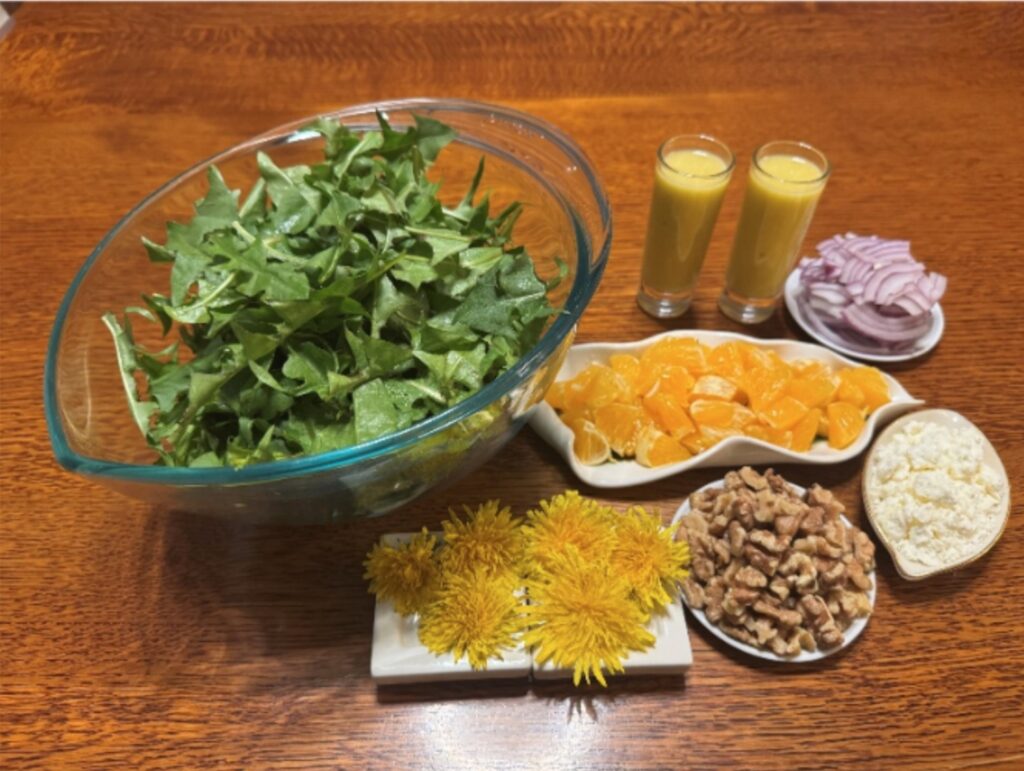
Combine the salad ingredients in a large bowl by tossing together the dandelion greens, red onion, walnuts, feta cheese, and orange segments. Drizzle the citrus vinaigrette over the mixture and gently toss it again to coat it with the dressing. Season with salt and pepper to taste.
Finish the dandelion salad by topping it with some vibrant yellow dandelion petals. Gently pinch off the green base from the bottom of the bloom to remove the petals from the washed dandelion blooms and sprinkle them over the salad.
Note: If you are preparing several items for a brunch service, this salad can be conveniently prepped in advance, with the final tossing of the ingredients occurring just before serving. Begin by preparing the dressing and storing it in a separate container. Next, combine all salad ingredients except for the orange sections and the flower bloom garnish. Just before serving, gently toss the salad greens with the orange sections and citrus dressing. Finally, top the salad with the flower petals as a garnish and serve.
Alternative suggestion: If you don’t have time to harvest dandelion greens, this salad recipe works well with other bitter greens such as kale, arugula, Swiss chard, collard greens, or mustard greens.
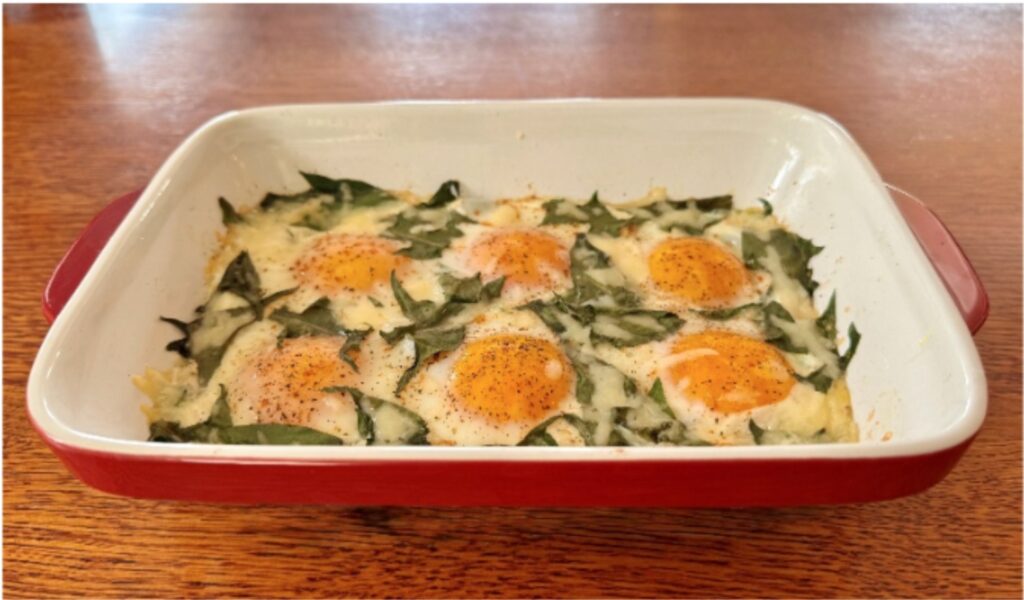
Sunny Dandelion Eggs
Ingredients:
6 eggs
1 cup of dandelion greens, washed and torn into bite-sized pieces
2 to 3 ounces of cheese (Asiago, Gruyere, Fontina, Swiss, and white cheddar all work well)
1 tablespoon butter, room temperature
Sea salt, freshly ground pepper, and ground cayenne pepper to taste
Makes 3 servings of two eggs each.
Preheat the oven to 375°
Start by buttering the bottom and sides of a small baking pan. Next, line the pan with dandelion greens, and then sprinkle cheese evenly over the greens. Make small indents where you will place each egg to ensure they sit properly in the baking pan.
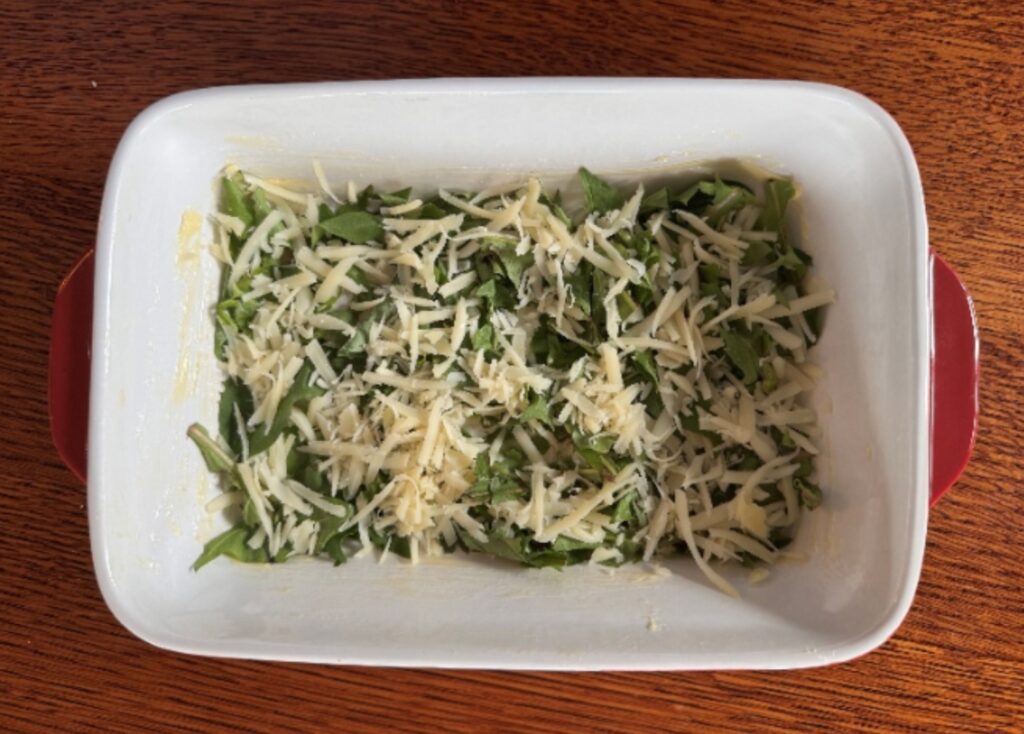
Then crack the eggs into the baking pan, being careful not to break the yolks. Sprinkle salt, pepper, and cayenne pepper over the eggs. Finish by garnishing the eggs with a few small pieces of dandelion greens.
Bake in the oven at 375°F for 15 to 20 minutes, or until the egg whites are set and the yolks reach your preferred consistency. Once you remove the dish from the oven, allow it to cool for a minute or two to allow the eggs set. Serve while still hot, and enjoy.
Serve while hot and enjoy with a side of dandelion salad or hash brown potatoes.
Bonus dandelion suggestion for halibut.
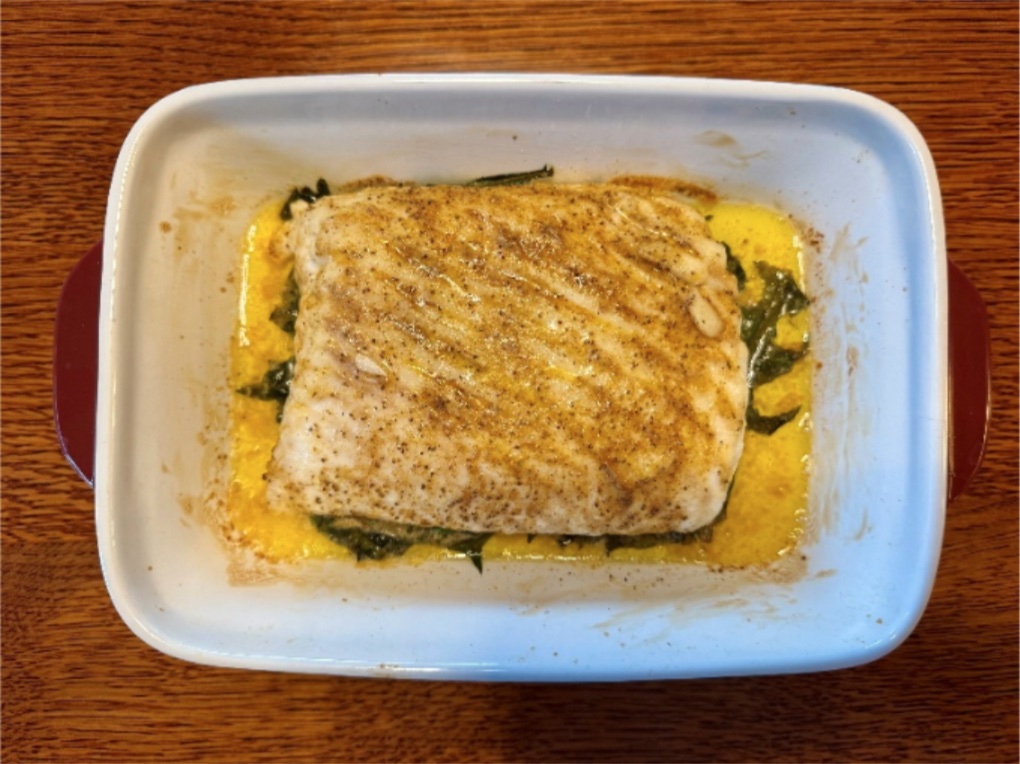
Dandelion Baked Halibut
Ingredients:
1 large filet of halibut
1 cup of dandelion greens, washed and torn into bite-sized pieces
1 to 2 tablespoons butter, room temperature
Sea salt, freshly ground pepper, and ground cayenne pepper to taste
Total servings depend on the size of the halibut filet.
Preheat the oven to 375°.
Begin by buttering the bottom and sides of a small baking pan. Next, place dandelion greens in the bottom of the pan. Season all sides of the halibut by lightly sprinkling it with salt, pepper, and cayenne pepper, or use a spicy seasoning of your choice.
Place the halibut in the pan on top of the dandelion greens and spread a layer of butter evenly over the top. Then, lightly season the top surface of the halibut with an even coating of your chosen spices.
Bake in the oven at 375°F. The baking time will vary based on the size of the filet, typically ranging from 12 to 20 minutes. Be careful not to overbake.
This preparation provides a fantastic way to enjoy dandelion, adding a savory element that complements the mild flavor of halibut.
Serve the dish hot from the oven for the best flavor, and enjoy!
Brenda Josephson is a Haines resident. She holds degrees in Culinary Arts and Food Business Leadership from the Culinary Institute of America, Hyde Park, New York. She enjoys spending time fishing, foraging, and savoring Alaska’s abundance of natural and wild foods with her family.
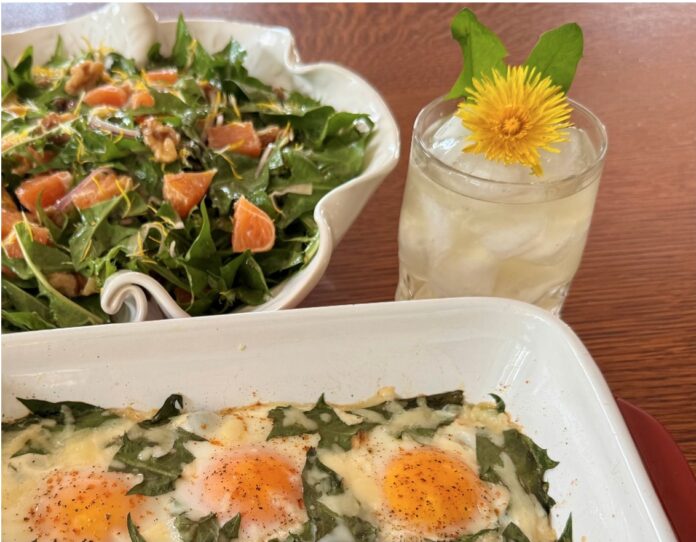
Fantastic article! No dandelions yet in Fairbanks along the river. When they do start to take over the lawn, I’ll know what to do with them. Thank you!
I look forward to trying out the tea recipe. Thank you, Brenda.